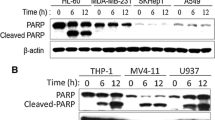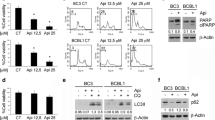Abstract
Paclitaxel has significant antitumor activity in several human tumors, including Kaposi’s sarcoma (KS). Human herpesvirus 8 (HHV-8) is implicated in all forms of Kaposi’s sarcoma, primary effusion lymphoma (PEL), and multicentric Castleman’s disease (MCD), indicating that it is a DNA tumor virus. Since it is difficult to culture cell lines derived from KS patients, we used a cell line derived from PEL (BCBL-1) to investigate whether oxidative stress is involved in the cytotoxicity of paclitaxel on the HHV-8-related tumors. We found that the generation of reactive oxygen species (ROS) in the BCBL-1 cells was increased by paclitaxel treatment, and the increase in ROS production was suppressed by antioxidants, including catalase and ascorbic acid. Moreover, ascorbic acid also attenuated the cytotoxicity induced by paclitaxel. Upon paclitaxel treatment, caspase-2, caspase-3, and caspase-8 were activated in BCBL-1 cells. Cotreatment with antioxidants did not affect caspase-2, caspase-3 or caspase-8 activation. Paclitaxel-induced apoptosis was also accompanied by an increase in the protein levels of Bax, and this effect was attenuated by antioxidants. Paclitaxel slightly decreased the expression of Bcl-2 protein, but antioxidants induced Bcl-2 protein. These results suggest that oxidative stress is only partially involved in the cytotoxicity of paclitaxel in BCBL-1 cells, and that paclitaxel-induced apoptosis of BCBL-1 cells is primarily mediated by the caspase activation pathway.







Similar content being viewed by others
References
Andre N, Braguer D, Brasseur G, Goncalves A, Lemesle-Meunier D, Guise S, Jordan MA, Briand C (2000) Paclitaxel induces release of cytochrome c from mitochondria isolated from human neuroblastoma cells. Cancer Res 60:5349–5353
Boshoff C, Whitby D, Hatziioannou T, Fisher C, van der Walt J, Hatzakis A, Weiss R, Schulz T (1995) Kaposi’s-sarcoma-associated herpesvirus in HIV-negative Kaposi’s sarcoma. Lancet 345:1043–1044
Cattelan AM, Trevenzoli M, Aversa SM (2002) Recent advances in the treatment of AIDS-related Kaposi’s sarcoma. Am J Clin Dermatol 3:451–462
Cesarman E, Chang Y, Moore PS, Said JW, Knowles DM (1995) Kaposi’s sarcoma-associated herpesvirus-like DNA sequences in AIDS-related body-cavity-based lymphomas. N Engl J Med 332:1186–1191
Chandra J, Samali A, Orrenius S (2000) Triggering and modulation of apoptosis by oxidative stress. Free Radic Biol Med 29:323–333
Debatin KM, Poncet D, Kroemer G (2002) Chemotherapy: targeting the mitochondrial cell death pathway. Oncogene 21:8786–8803
Dupin N, Grandadam M, Calvez V, Gorin I, Aubin JT, Havard S, Lamy F, Leibowitch M, Huraux JM, Escande JP, Agut H (1995) Herpesvirus-like DNA sequences in patients with Mediterranean Kaposi’s sarcoma. Lancet 345:761–762
Frenkel K, Gleichauf C (1991) Hydrogen peroxide formation by cells treated with a tumor promoter. Free Radic Res Commun 12–13:783–794
Goncalves A, Braguer D, Kamath K, Martello L, Braind C, Horwitz S, Wilson L, Jordan MA (2001) Resistance to Taxol in lung cancer cells associated with increased microtubule dynamics. Proc Natl Acad Sci U S A 98:11737–11742
Groninger E, Meeuwsen-De Boer GJ, De Graaf SS, Kamps WA, De Bont ES (2002) Vincristine induced apoptosis in acute lymphoblastic leukaemia cells: a mitochondrial controlled pathway regulated by reactive oxygen species? Int J Oncol 21:1339–1345
Haendeler J, Zeiher AM, Dimmeler S (1996) Vitamin C and E prevent lipopolysaccharide-induced apoptosis in human endothelial cells by modulation of Bcl-2 and Bax. Eur J Pharmacol 317:407–411
Horwitz SB (1992) Mechanism of action of taxol. Trends Pharmacol Sci 13:134–136
Jordan MA, Wendell K, Gardiner S, Derry WB, Copp H, Wilson L (1996) Mitotic block induced in HeLa cells by low concentrations of paclitaxel (Taxol) results in abnormal mitotic exit and apoptotic cell death. Cancer Res 56:816–825
Kim R, Tanabe K, Uchida Y, Emi M, Inoue H, Toge T (2002) Current status of the molecular mechanisms of anticancer drug-induced apoptosis. The contribution of molecular-level analysis to cancer chemotherapy. Cancer Chemother Pharmacol 50:343–352
Kumar N (1981) Taxol-induced polymerization of purified tubulin. Mechanism of action. J Biol Chem 256:10435–10441
LeBel CP, Ischiropoulos H, Bondy SC (1992) Evaluation of the probe 2′,7′-dichlorofluorescein as an indicator of reactive oxygen species formation and oxidative stress. Chem Res Toxicol 5:227–231
Liebmann JE, Cook JA, Lipschultz C, Teague D, Fisher J, Mitchell JB (1993) Cytotoxic studies of paclitaxel (Taxol) in human tumour cell lines. Br J Cancer 68:1104–1109
Lowe SW, Lin AW (2000) Apoptosis in cancer. Carcinogenesis 21:485–495
McCloskey DE, Kaufmann SH, Prestigiacomo LJ, Davidson NE (1996) Paclitaxel induces programmed cell death in MDA-MB-468 human breast cancer cells. Clin Cancer Res 2:847–854
McGarvey ME, Tulpule A, Cai J, Zheng T, Masood R, Espina B, Arora N, Smith DL, Gill PS (1998) Emerging treatments for epidemic (AIDS-related) Kaposi’s sarcoma. Curr Opin Oncol 10:413–421
Moore PS, Chang Y (1995) Detection of herpesvirus-like DNA sequences in Kaposi’s sarcoma in patients with and without HIV infection. N Engl J Med 332:1811–1185
Oyaizu H, Adachi Y, Taketani S, Tokunaga R, Fukuhara S, Ikehara S (1999) A crucial role of caspase 3 and caspase 8 in paclitaxel-induced apoptosis. Mol Cell Biol Res Commun 2:36–41
Paroni G, Henderson C, Schneider C, Brancolini C (2001) Caspase-2-induced apoptosis is dependent on caspase-9, but its processing during UV- or tumor necrosis factor-dependent cell death requires caspase-3. J Biol Chem 276:21907–21915
Rodi DJ, Janes RW, Sanganee HJ, Holton RA, Wallace BA, Makowski L (1999) Screening of a library of phage-displayed peptides identifies human bcl-2 as a taxol-binding protein. J Mol Biol 285:197–203
Sarosy G, Reed E (1993) Taxol dose intensification and its clinical implications. J Natl Med Assoc 85:427–431
Schiff PB, Horwitz SB (1981) Taxol assembles tubulin in the absence of exogenous guanosine 5′-triphosphate or microtubule-associated proteins. Biochemistry 20:3247–3252
Schiff PB, Fant J, Horwitz SB (1979) Promotion of microtubule assembly in vitro by taxol. Nature 277:665–667
Soulier J, Grollet L, Oksenhendler E, Cacoub P, Cazals-Hatem D, Babinet P, d’Agay MF, Clauvel JP, Raphael M, Degos L, Sigaux F (1995) Kaposi’s sarcoma-associated herpesvirus-like DNA sequences in multicentric Castleman’s disease. Blood 86:1276–1280
Sturzl M, Zietz C, Monini P, Ensoli B (2001) Human herpesvirus-8 and Kaposi’s sarcoma: relationship with the multistep concept of tumorigenesis. Adv Cancer Res 81:125–159
Varbiro G, Veres B, Gallyas F Jr, Sumegi B (2001) Direct effect of Taxol on free radical formation and mitochondrial permeability transition. Free Radic Biol Med 31:548–558
Zhou HB, Zhu JR (2003) Paclitaxel induces apoptosis in human gastric carcinoma cells. World J Gastroenterol 9:442–445
Acknowledgements
This work was partially supported by Fooyin University grant FY-91-015. We would like to thank Dr. Gary R. Whittaker for proofreading the manuscript.
Author information
Authors and Affiliations
Corresponding author
Rights and permissions
About this article
Cite this article
Wang, YF., Chen, CY., Chung, SF. et al. Involvement of oxidative stress and caspase activation in paclitaxel-induced apoptosis of primary effusion lymphoma cells. Cancer Chemother Pharmacol 54, 322–330 (2004). https://doi.org/10.1007/s00280-004-0831-0
Received:
Accepted:
Published:
Issue Date:
DOI: https://doi.org/10.1007/s00280-004-0831-0




